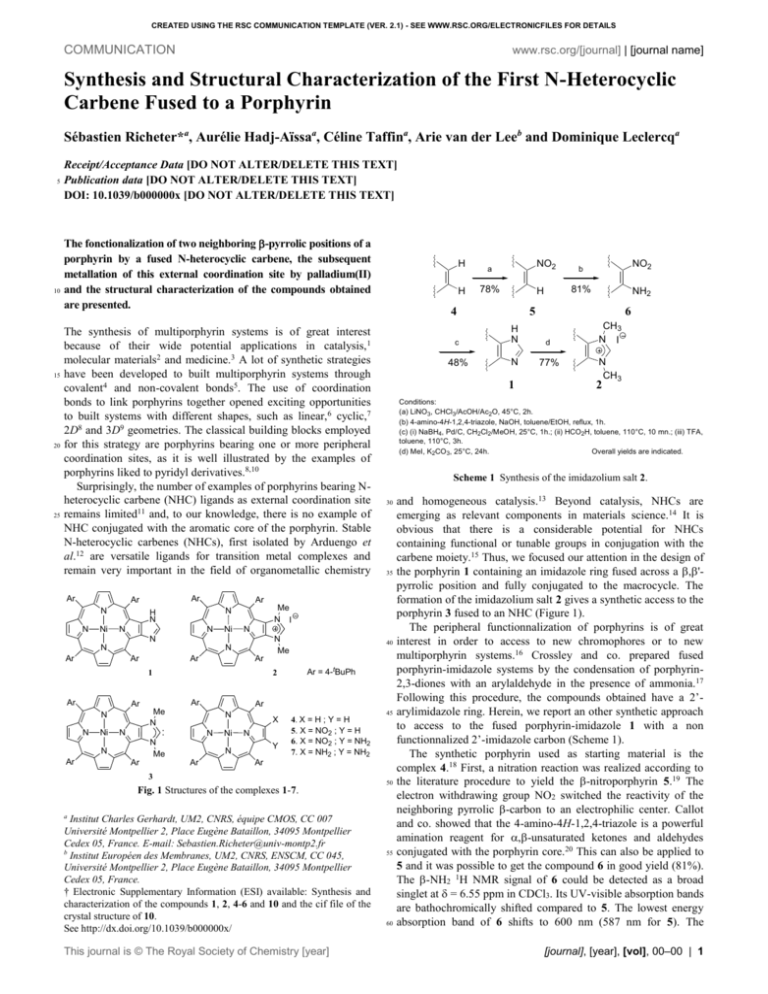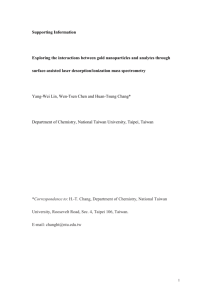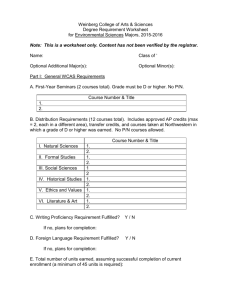RSC Communication Template (Version 2.1)
advertisement

CREATED USING THE RSC COMMUNICATION TEMPLATE (VER. 2.1) - SEE WWW.RSC.ORG/ELECTRONICFILES FOR DETAILS COMMUNICATION www.rsc.org/[journal] | [journal name] Synthesis and Structural Characterization of the First N-Heterocyclic Carbene Fused to a Porphyrin Sébastien Richeter*a, Aurélie Hadj-Aïssaa, Céline Taffina, Arie van der Leeb and Dominique Leclercqa 5 10 15 20 25 Receipt/Acceptance Data [DO NOT ALTER/DELETE THIS TEXT] Publication data [DO NOT ALTER/DELETE THIS TEXT] DOI: 10.1039/b000000x [DO NOT ALTER/DELETE THIS TEXT] The fonctionalization of two neighboring -pyrrolic positions of a porphyrin by a fused N-heterocyclic carbene, the subsequent metallation of this external coordination site by palladium(II) and the structural characterization of the compounds obtained are presented. The synthesis of multiporphyrin systems is of great interest because of their wide potential applications in catalysis,1 molecular materials2 and medicine.3 A lot of synthetic strategies have been developed to built multiporphyrin systems through covalent4 and non-covalent bonds5. The use of coordination bonds to link porphyrins together opened exciting opportunities to built systems with different shapes, such as linear,6 cyclic,7 2D8 and 3D9 geometries. The classical building blocks employed for this strategy are porphyrins bearing one or more peripheral coordination sites, as it is well illustrated by the examples of porphyrins liked to pyridyl derivatives.8,10 Surprisingly, the number of examples of porphyrins bearing Nheterocyclic carbene (NHC) ligands as external coordination site remains limited11 and, to our knowledge, there is no example of NHC conjugated with the aromatic core of the porphyrin. Stable N-heterocyclic carbenes (NHCs), first isolated by Arduengo et al.12 are versatile ligands for transition metal complexes and remain very important in the field of organometallic chemistry Ar Ar Ar N N Ni N Ni N Me Ar Ar Ar N Ni N N N N Me Ar Ni X 4. X = H ; Y = H 5. X = NO2 ; Y = H 6. X = NO2 ; Y = NH2 7. X = NH2 ; Y = NH2 N Y N Ar 30 35 Ar Me N N Ar Ar Ar N Ar = 4-tBuPh 45 Ar 3 Fig. 1 Structures of the complexes 1-7. 50 a Institut Charles Gerhardt, UM2, CNRS, équipe CMOS, CC 007 Université Montpellier 2, Place Eugène Bataillon, 34095 Montpellier Cedex 05, France. E-mail: Sebastien.Richeter@univ-montp2.fr b Institut Européen des Membranes, UM2, CNRS, ENSCM, CC 045, Université Montpellier 2, Place Eugène Bataillon, 34095 Montpellier Cedex 05, France. † Electronic Supplementary Information (ESI) available: Synthesis and characterization of the compounds 1, 2, 4-6 and 10 and the cif file of the crystal structure of 10. See http://dx.doi.org/10.1039/b000000x/ This journal is © The Royal Society of Chemistry [year] NO2 81% NH2 5 6 c H N d 48% N 77% CH3 N I N CH3 2 Scheme 1 Synthesis of the imidazolium salt 2. 40 2 H 1 Ar 1 78% b Conditions: (a) LiNO 3, CHCl3/AcOH/Ac2O, 45°C, 2h. (b) 4-amino-4H-1,2,4-triazole, NaOH, toluene/EtOH, reflux, 1h. (c) (i) NaBH4, Pd/C, CH2Cl2/MeOH, 25°C, 1h.; (ii) HCO2H, toluene, 110°C, 10 mn.; (iii) TFA, toluene, 110°C, 3h. (d) MeI, K2CO 3, 25°C, 24h. Overall yields are indicated. N N NO2 a 4 Me N I N N Ar H Ar N H N N H 55 60 and homogeneous catalysis.13 Beyond catalysis, NHCs are emerging as relevant components in materials science.14 It is obvious that there is a considerable potential for NHCs containing functional or tunable groups in conjugation with the carbene moiety.15 Thus, we focused our attention in the design of the porphyrin 1 containing an imidazole ring fused across a ,'pyrrolic position and fully conjugated to the macrocycle. The formation of the imidazolium salt 2 gives a synthetic access to the porphyrin 3 fused to an NHC (Figure 1). The peripheral functionnalization of porphyrins is of great interest in order to access to new chromophores or to new multiporphyrin systems.16 Crossley and co. prepared fused porphyrin-imidazole systems by the condensation of porphyrin2,3-diones with an arylaldehyde in the presence of ammonia.17 Following this procedure, the compounds obtained have a 2’arylimidazole ring. Herein, we report an other synthetic approach to access to the fused porphyrin-imidazole 1 with a non functionnalized 2’-imidazole carbon (Scheme 1). The synthetic porphyrin used as starting material is the complex 4.18 First, a nitration reaction was realized according to the literature procedure to yield the -nitroporphyrin 5.19 The electron withdrawing group NO2 switched the reactivity of the neighboring pyrrolic -carbon to an electrophilic center. Callot and co. showed that the 4-amino-4H-1,2,4-triazole is a powerful amination reagent for ,-unsaturated ketones and aldehydes conjugated with the porphyrin core.20 This can also be applied to 5 and it was possible to get the compound 6 in good yield (81%). The -NH2 1H NMR signal of 6 could be detected as a broad singlet at = 6.55 ppm in CDCl3. Its UV-visible absorption bands are bathochromically shifted compared to 5. The lowest energy absorption band of 6 shifts to 600 nm (587 nm for 5). The [journal], [year], [vol], 00–00 | 1 CREATED USING THE RSC COMMUNICATION TEMPLATE (VER. 2.1) - SEE WWW.RSC.ORG/ELECTRONICFILES FOR DETAILS H N elimination NH2 1 H N H2CO2H toluene N OH H N N H NH2 H O esterification 7 O N H 8 9 Scheme 2 65 70 75 80 85 diaminoporphyrin 7 was obtained by the reduction of the NO2 group of 6 with NaBH4 in the presence of methanol and Pd/C.21 The porphyrin 7 was not isolated but used straightforward for the formation of the imidazole ring. The cyclization reaction with formic acid was more challenging and realized in two steps compared to the classical procedure described for 2,3-diaminobenzene derivatives (one quantitative step).22 First, the alcohol 8 was obtained by the complete condensation reaction of 7 with formic acid in refluxing toluene (1:1 mixture) in less than 10 minutes. Then, two competitive reactions occur in these conditions: the formation of the porphyrin-imidazole 1 by the elimination of a molecule of water and the formation of the ester 9 (Scheme 2). To prevent the formation of the undesirable ester, it was preferable to change the reaction conditions after the formation of the alcohol 8. The imidazole 1 was preferentially obtained by the slow addition of TFA to a refluxing solution of 8 in toluene. The overall yield from 6 to 1 was 48%. The 1H NMR spectrum of 1 in CDCl3 shows broad signals due to the slow imidazole tautomerism on the 1H NMR timescale. The double N-alkylation of the imidazole ring of 1 with iodomethane yields the corresponding imidazolium salt 2 in 76% yield. A sharp singlet at = 11.50 ppm corresponding to the iminium C(2’)-H is observed in the 1H NMR spectrum (C6D6) of 2. This downfield chemical shift shows the highly electron-withdrawing nature of the metalloporphyrin macrocycle. Ar Ar Pd(OAc)2 2 toluene reflux 76% Ar = 4-tBuPh 90 95 100 N Ni N N Ar Ar 105 110 115 Ar Ar Me Me I N N Pd N N I Me Me N Fig. 2 Two views of the X-ray structure of the complex 10 (solvent molecules have been omitted for clarity). C in gray, N in blue, Ni in yellow, Pd in orange and I in purple. (a) t-butyl groups and H omitted for clarity. (b) meso aryl groups and H omitted for clarity. N N Ni N 120 N Ar Ar 10 Scheme 3 Synthesis of the complex 10 Then, we investigated the possibility to generate the carbene fused to the porphyrin 3. As a proof of its existence, we performed the direct metallation of 2 with the basic metal precursor Pd(OAc)2 in refluxing toluene.23 This reaction proceeded smoothly leading to the formation of the complex 10 which was purified by chromatography on silica gel (Scheme 3). No signal corresponding to the iminium proton was observed by 1H NMR spectroscopy (CDCl ) showing the formation of the 3 NHC–Pd(II) bond. The evidence of the formation of the complex 10 was also provided by FAB+ mass spectrometry. The molecular pic corresponding to the dimer was observed at m/z = 2289. Two fragments were observed at m/z = 2162 and 1324 and correspond to the dimer whose one ligand was removed, respectively the iodine and the porphyrin-NHC. The signal observed at m/z = 963 corresponds to the cationic porphyrin 2. The UV-visible 2 | [journal], [year], [vol], 00–00 125 130 absorption bands of 10 are slightly broadened and red-shifted compared to those of the imidazolium 2. This result trends to show that there is negligible ground state electronic communication between the prophyrins through the palladium center. The single-crystal X-ray analysis† unambiguously establish the structure of the complex 10 and the trans geometry around the palladium (II) (Figure 2). The two porphyrin moieties are not flat but are ruffled because the C(5)-Ni-C(15) and C(10)-Ni-C(20) angles are close to 165°. Despite this distorded geometry of the aromatic core of the porphyrin, the additional imidazoylidene ring and the adjacent pyrrole are coplanar. The nickel (II) was found in an slightly distorded square planar geometry: the four Ni–N distances are almost equivalent (1.900, 1.906, 1.924, and 1.960 Å) and the four N–Ni–N angles are close to 90° (88.45, 90.09, 91.16, and 91.29°). In this square-planar trans palladium (II) complex, the Pd–C distances which are consistent with Pd–C single bonds (2.037 Å) are shorter than the Pd–I distances (2.591 Å). The two imidazoylidene rings are close to coplanarity and are tilted ~82° from the square panar central plane PdI2C2. This tilted conformation minimizes the steric interactions between the methyl groups and the iodines linked to the palladium (II) but also the steric interactions between the tBu groups close to the palladium center. To conclude, we have presented here a new synthetic procedure to obtain a porphyrin with an additional imidazole ring fused across a ,’-pyrrolic position. We have shown that it is possible to generate an NHC at the periphery of a porphyrin and to use it as a coordination site to built multiporphyrin assemblies. We are currently studying the tuning of the optical and redox properties of the NHC-porphyrin systems. The synthesis od bis(NHC)porphyrins are also under investigation. Notes and references 135 † Crystallographic data were recorded with an Xcalibur CCD camera (Oxford Diffraction) using graphite monochromated Mo Ka radiation ( = 0.71073 Å), 40 s per frame. The structure was solved using Patterson methods 24 and refined using full-matrix least squares methods 25. This journal is © The Royal Society of Chemistry [year] CREATED USING THE RSC COMMUNICATION TEMPLATE (VER. 2.1) - SEE WWW.RSC.ORG/ELECTRONICFILES FOR DETAILS 140 145 150 155 160 165 170 175 180 185 190 195 200 205 Hydrogen atoms (except one belonging to a chloroform molecule) were located from the Fourier difference map and not refined. Crystal data for 10·4CHCl3: C130H132Cl12I2N12Ni2Pd, MW = 2765.48, monoclinic, space group P 1 21/c 1 (no. 14), a = 22.1838(7) Å, b = 9.9174(4) Å, c = 31.4826(13) Å, = 103.73(0)°, V = 6728.43(50) Å3, Z = 2, dcalcd=1.365 g/cm3, T = 173 K, (Mo K) = 0.71073 Å, (Mo K) = 0.128 mm-1, 18567 reflns collected, 3351 unique reflns I>2(I), RF = 0.263 and wRF = 0.0887 for all reflections, RF = 0.0764 and wRF.= 0.0527 for observed reflections. 1 D. Mansuy, Coord. Chem. Rev., 1993, 125, 129; L. M Slaughter, E. Galardon, P. Le Maux and G. Simonneaux, Chem. Commun., 1997, 927; J. P. Collman, T. A. Eberspacher and J. I. Brauman, Inorg. Chem., 2004, 43, 5198; J. P. Collman, L. Zeng, H. J. H. Wang, A. Lei and J. I. Brauman, Chem. Eur. J., 2006, 12, 2707. 2 M. G. H. Vicente, L. Jaquinod and K. M. Smith, Chem. Commun., 1999, 1771; H. L. Anderson, Chem. Commun., 1999, 2323. 3 X. Chen, L. Hui, D. A. Foster and C. M. Drain, Biochemistry, 2004, 43, 10918 ; C. E. Stilts, M. I. Nelen, D. G. Hilmey, S. R. Davies, S. O. Gollnick, A. R. Oseroff, S. L. Gibson, R. Hilf and M. R. Detty, J. Med. Chem., 2000, 43, 2403; H. Gu, K. Xu, Z. Yang, C. K. Chang and B. Xu, Chem. Commun., 2005, 4270. 4 A. K. Burrell, D. L. Officer, P. G. Plieger and D. C. W. Reid, Chem. Rev., 2001, 101, 2751. 5 J. Wojaczynski and L. Latos-Grazynski, L. Coord. Chem. Rev., 2000, 204, 113. 6 C. Ikeda, E. Fujiwara, A. Satake and Y. Kobuke, Chem. Commun., 2003, 616; U. Michelsen and C. A. Hunter, Angew. Chem., Int. Ed., 2000, 39, 764. 7 R. Takahashi and Y. Kobuke, J. Am. Chem. Soc., 2003, 125, 2372; R. A. Haycock, A. Hunter, D. A. James, U. Michelsen and L. R. Sutton, Org. Lett., 2000, 2, 2435. 8 C. M. Drain, F. Nifiatis, A. Vasenko and J. D. Batteas, Angew. Chem., Int. Ed., 1998, 37, 2344. 9 I. Goldberg, Chem. Commun., 2005, 1243; I. Goldberg, Chem. Eur. J., 2000, 6, 3863; Y. Diskin-Posner, S. Dahal and I. Goldberg, Angew. Chem., Int. Ed., 2000, 39, 1288. 10 A. Tsuda, T. Nakamura, S. Sakamoto, K. Yamaguchi and A. Osuka, Angew. Chem., Int. Ed., 2002, 41, 2817; N. Fujita, K. Biradha, M. Fujita, S. Sakamoto and K. Yamaguchi, Angew. Chem., Int. Ed., 2001, 40, 1718; A. Harriman, F. Odobel and J. –P. Sauvage, J. Am. Chem. Soc., 1994, 116, 5481. 11 V. Seng, X. Wang, R. Ali, W. Fang, F. Charles-Pierre, S. Bhagan and A. G. Hyslop, J. Heter. Chem., 2006, 43, 1077. 12 A. J. Arduengo III, R. L. Harlow and M. Kline, J. Am. Chem. Soc., 1991, 113, 361; A. J. Arduengo III, H. V. Rasika Dias, R. L. Harlow and M. Kline, J. Am. Chem. Soc., 1992, 114, 5530. 13 W. A. Herrmann and C. Köcher, Angew. Chem., Int. Ed., 1997, 36, 2163; D. Bourissou, O. Guerret, F. P. Gabbaï and G. Bertrand, Chem. Rev., 2000, 100, 39; W. A. Herrmann, Angew. Chem., Int. Ed., 2002, 41, 1290; M. C. Perry and K. Burgess, Tetrahedron: Asymmetry, 2003, 14, 951; E. Peris and R. H. Crabtree, Coord. Chem. Rev., 2004, 248, 2239, K. J. Cavell and D. S. McGuinness, Coord. Chem. Rev., 2004, 248, 671; M. C. Crudden and D. P. Allen, Coord. Chem. Rev., 2004, 248, 2247; A. Zapf and M. Beller, Chem. Commun., 2005, 910; N. M. Scott and S. P. Nolan, Eur. J. Inorg. Chem., 2005, 1815. 14 S. -W. Zhang, R. Ishii and S. Takahashi, Organometallics, 1997, 16, 20; O. Guerret, S. Solé, H. Gornitzka, M. Teichert, G. Trinquier and G. Bertrand, J. Am. Chem. Soc., 1997, 119, 6668; C. K. Lee, J. C. C. Chen, K. M. Lee, C. W. Liu and I. J. B. Lin, Chem. Mater., 1999, 11, 1237; A. J. Boydston, K. A. Williams and C. W. Bielawski, J. Am. Chem. Soc., 2005, 127, 12496; A. J. Boydston and C. W. Bielawski, Dalton Trans., 2006, 4073. 15 M. D. Sanderson, J. W. Kamplain and C. W. Bielawski, J. Am. Chem. Soc., 2006, 128, 16514. 16 L. Jaquinod, in The Porphyrin Handbook, ed. K. M. Kadish, K. M. Smith and R. Guilard, Academic Press, San Diego, 2000, vol. 6, pp 201–237; P. S. S. Lacerda, A. M. G. Silva, A. C. Tomé, M. G. P. M. S. Neves, A. M. S. Silva, J. A. S. Cavaleiro and A. L. Llamas-Saiz, Angew. Chem., Int. Ed., 2006, 45, 5487. 17 M. J. Crossley, J. A. McDonald, J. Chem. Soc., Perkin Trans. 1, 1999, 2429. This journal is © The Royal Society of Chemistry 210 215 220 225 230 18 A. D. Adler, F. R. Longo, J. D. Finarelli, J. Goldmacher, J. Assour and L. Korsakoff, J. Org. Chem., 1967, 32, 476. The complex 4 was synthesized according to Adler’s methodology. See Supporting Information. 19 A. Giraudeau, H. J. Callot, J. Jordan, I. Ezahr and M. Gross, J. Am. Chem. Soc., 1979, 101, 3857; A. W. Johnson, D. J. Oldfield, J. Chem. Soc., 1965, 4303. 20 S. Richeter, C. Jeandon, R. Ruppert and H. J. Callot, Chem. Commun., 2002, 266; S. Richeter, C. Jeandon, J. –P. Gisselbrecht, R. Ruppert and H. J. Callot, J. Am. Chem. Soc., 2002, 124, 6168; S. Richeter, C. Jeandon, J. –P. Gisselbrecht, R. Graff, R. Ruppert and H. J. Callot, Inorg. Chem., 2004, 43, 251. 21 J. E. Baldwin, M. J. Crossley and J. DeBernardis, Tetrahedron, 1982, 38, 685; V. Promarak and P. A. Burn, J. Chem. Soc., Perkin Trans. 1, 2001, 14. 22 E. C. Wagner and W. H. Millett, Org. Synth., 1939, 19, 12. 23 W. A. Herrmann, M. Elison, J. Fischer, C. Kocher and G. R. J. Artus, Angew. Chem., Int. Ed. 1995, 34, 2371. 24 P. T. Beurskens, G. Beurskens, W. P. Bosman, R. de Gelder, S. Garcia Granda, R. O. Gould, R. Israel and J.M.M. Smits, in 'a Computer Program System for Crystallography Laboratory,' Nijmegen, 1996. 25 P. W. Betteridge, J. R. Carruthers, R. I. Cooper, K. Prout and D. J. Watkin, J. Appl. Cryst, 2003, 36, 1487. [journal], [year], [vol], 00–00 | 3 CREATED USING THE RSC COMMUNICATION TEMPLATE (VER. 2.1) - SEE WWW.RSC.ORG/ELECTRONICFILES FOR DETAILS 4 | [journal], [year], [vol], 00–00 This journal is © The Royal Society of Chemistry [year]






